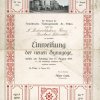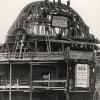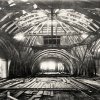Detailed building history: from draft concept to inauguration
The Synagogue of St. Pölten is considered one of the most significant sacral building of its days. It was designed by Theodor Schreier together with his co-partner Viktor Postelberg. Theodor Schreier was born in Vienna on December 8th, 1873 and between 1899 and 1906 he worked in an atelier with the Viennese architect Ernst Lindner. In 1943 Schreier was deported to Theresienstadt and died there after May 21st.
In order to obtain funding for the synagogue, Albert Leicht, head of the Israelite Religious Community, organised two fund-raising campaigns: the sending of postcards of the new synagogue and the sale of prayer books. The overall costs for the new construction including the interior amounted to 141.390 crowns. More than half of that amount was raised via private donations. On the Torah Shrine, a golden inscription in Hebrew letters and German language states "donated by the Women’s Association St. Pölten". The couple Siegfried and Bertha Schwarz donated 160 crowns for a colourfully glazed window in the shape of a David’s Star. As is the case with all the other resplendent colourful windows of the synagogue, it is no longer preserved.
In April 1912, Rabi Schächter requested that Jewish holidays be abode by in accordance with religious regulations as regarded the construction of the synagogue. The Israelite Religious Community decided in an unanimous vote that Saturdays and holidays would not see any construction works in spite of higher costs. On June 20th, 1912, construction activity started.
The date for the inauguration – the eve of the emperor’s birthday – was chosen as a sign of reverence for Emperor Franz Josef I; there had even been considerations on putting up a bust of the emperor in the ante-room of the synagogue. The musical arrangement for that evening were made by St. Pölten’s cantor Philipp Wolf Rabinowitsch and the chief cantor of the Israelite Religious Community Vienna, Don Fuchs together with the choir of the Vienna Sephardic community. As a matter of course the evening closed with the Imperial Anthem.
The inauguration was attended by numerous secular and religious dignitaries. Representatives of the Catholic Church, however, were not present and the "St. Pöltner Zeitung" (St. Pölten’s Newspaper) which was strongly catholic and anti-Semitic did not mention the event.
In June 1923, the community embellished the interior with a magnificent Art Deco chandelier.


